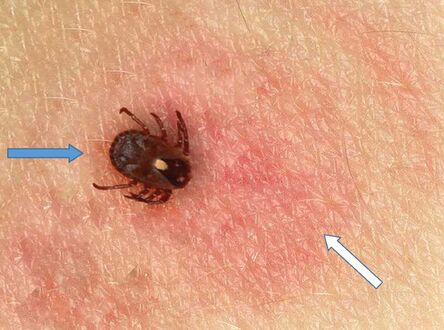Southern tick-associated rash illness
| Southern tick-associated rash illness | |
|---|---|
| Other names: Masters' disease | |
 | |
| Lone star ticks can be carriers of southern tick-associated rash illness. | |
| Specialty | Infectious disease |
Southern tick-associated rash illness (STARI) is an emerging infectious disease related to Lyme disease that occurs in southeastern and south-central United States. It is spread by tick bites and it was hypothesized that the illness was caused by the bacteria Borrelia lonestari. However, there is insufficient evidence to declare this Borrelia strain as a causative agent.
Symptoms and signs
In terms of the symptoms of STARI we find that they are mild, and resemble influenza, with fatigue, muscle pains, and headache.[1]
Fever is sometimes seen, but is not characteristic.
-
Lone star tick causing Southern tick-associated rash illness, and target erythematous lesion on right leg
-
"Bull's-eye" STARI rash
Causes
This illness is a tick-borne disease carried by the lone star tick Amblyomma americanum. This tick was first proposed as a possible vector of disease in 1984,[2] and the illnesses associated with the tick called "Lyme-like disease",[3] but it was not recognized to be distinct from Lyme disease until the late 1990s.[4][1]
Several studies have failed to detect Borrelia burgdorferi, which is the causative agent of Lyme disease, in patients from the southern United States.[5][6] This disease may be caused by the related bacterium Borrelia lonestari,[7][8] which is a spirochete first isolated in culture in 2004.[9] However, this conclusion is controversial since the spirochete is not detected in all cases of the syndrome,[6] which has led some authors to argue that the illness is not caused by a bacterial pathogen.[10]
Diagnosis
Diagnosis is based on a circular "bull's-eye" rash at the site of infection called erythema chronicum migrans, which is very similar to that seen in Lyme disease[1]
Treatment
Infections are treated with antibiotics, particularly doxycycline, and the acute symptoms appear to respond to these drugs.[8][11]
Prognosis
No serious long-term effects are known for this disease,[11] but preliminary evidence suggests, if such symptoms do occur, they are less severe than those associated with Lyme disease.[7]
See also
References
- ↑ 1.0 1.1 1.2 Kirkland KB, Klimko TB, Meriwether RA, et al. (1997). "Erythema migrans-like rash illness at a camp in North Carolina: a new tick-borne disease?". Arch. Intern. Med. 157 (22): 2635–41. doi:10.1001/archinte.157.22.2635. PMID 9531233.
- ↑ Schulze TL, Bowen GS, Bosler EM, et al. (May 1984). "Amblyomma americanum: a potential vector of Lyme disease in New Jersey". Science. 224 (4649): 601–3. Bibcode:1984Sci...224..601S. doi:10.1126/science.6710158. PMID 6710158.
- ↑ Masters EJ, Donnell HD (July 1995). "Lyme and/or Lyme-like disease in Missouri". Missouri Medicine. 92 (7): 346–53. PMID 7651314.
- ↑ Masters E, Granter S, Duray P, Cordes P (August 1998). "Physician-diagnosed erythema migrans and erythema migrans-like rashes following Lone Star tick bites". Arch Dermatol. 134 (8): 955–60. doi:10.1001/archderm.134.8.955. PMID 9722725.
- ↑ Philipp MT, Masters E, Wormser GP, Hogrefe W, Martin D (October 2006). "Serologic Evaluation of Patients from Missouri with Erythema Migrans-Like Skin Lesions with the C6 Lyme Test". Clin. Vaccine Immunol. 13 (10): 1170–1. doi:10.1128/CVI.00238-06. PMC 1595329. PMID 17028220.
- ↑ 6.0 6.1 Wormser GP, Masters E, Liveris D, et al. (February 2005). "Microbiologic Evaluation of Patients from Missouri with Erythema Migrans". Clin. Infect. Dis. 40 (3): 423–8. doi:10.1086/427289. PMC 2773674. PMID 15668867.
- ↑ 7.0 7.1 Masters EJ, Grigery CN, Masters RW (June 2008). "STARI, or Masters disease: Lone Star tick-vectored Lyme-like illness". Infect. Dis. Clin. North Am. 22 (2): 361–76, viii. doi:10.1016/j.idc.2007.12.010. PMID 18452807.
- ↑ 8.0 8.1 James AM, Liveris D, Wormser GP, Schwartz I, Montecalvo MA, Johnson BJ (June 2001). "Borrelia lonestari infection after a bite by an Amblyomma americanum tick". J. Infect. Dis. 183 (12): 1810–4. doi:10.1086/320721. PMID 11372036.
- ↑ Varela AS, Luttrell MP, Howerth EW, et al. (March 2004). "First Culture Isolation of Borrelia lonestari, Putative Agent of Southern Tick-Associated Rash Illness". J. Clin. Microbiol. 42 (3): 1163–9. doi:10.1128/JCM.42.3.1163-1169.2004. PMC 356874. PMID 15004069.
- ↑ Dennis DT. (2006). "Reply to Masters. "Lyme-Like Illness Currently Deserves Lyme-Like Treatment"". Clinical Infectious Diseases. 42 (4): 581–582. doi:10.1086/500018. PMID 16421811.
- ↑ 11.0 11.1 Blanton L, Keith B, Brzezinski W (June 2008). "Southern Tick-Associated Rash Illness: Erythema Migrans Is Not Always Lyme Disease". South. Med. J. 101 (7): 759–760. doi:10.1097/SMJ.0b013e31817a8b3f. PMID 18580719.
External links
| Classification |
|---|
- Southern Tick-Associated Rash Illness (STARI) Home Page Archived 2017-10-24 at the Wayback Machine Centers for Disease Control
- STARI Fact Sheet Florida Department of Health
- Southern Tick-Associated Rash Illness (STARI) SCWDS Briefs, January 2003, Vol.18, No.4

